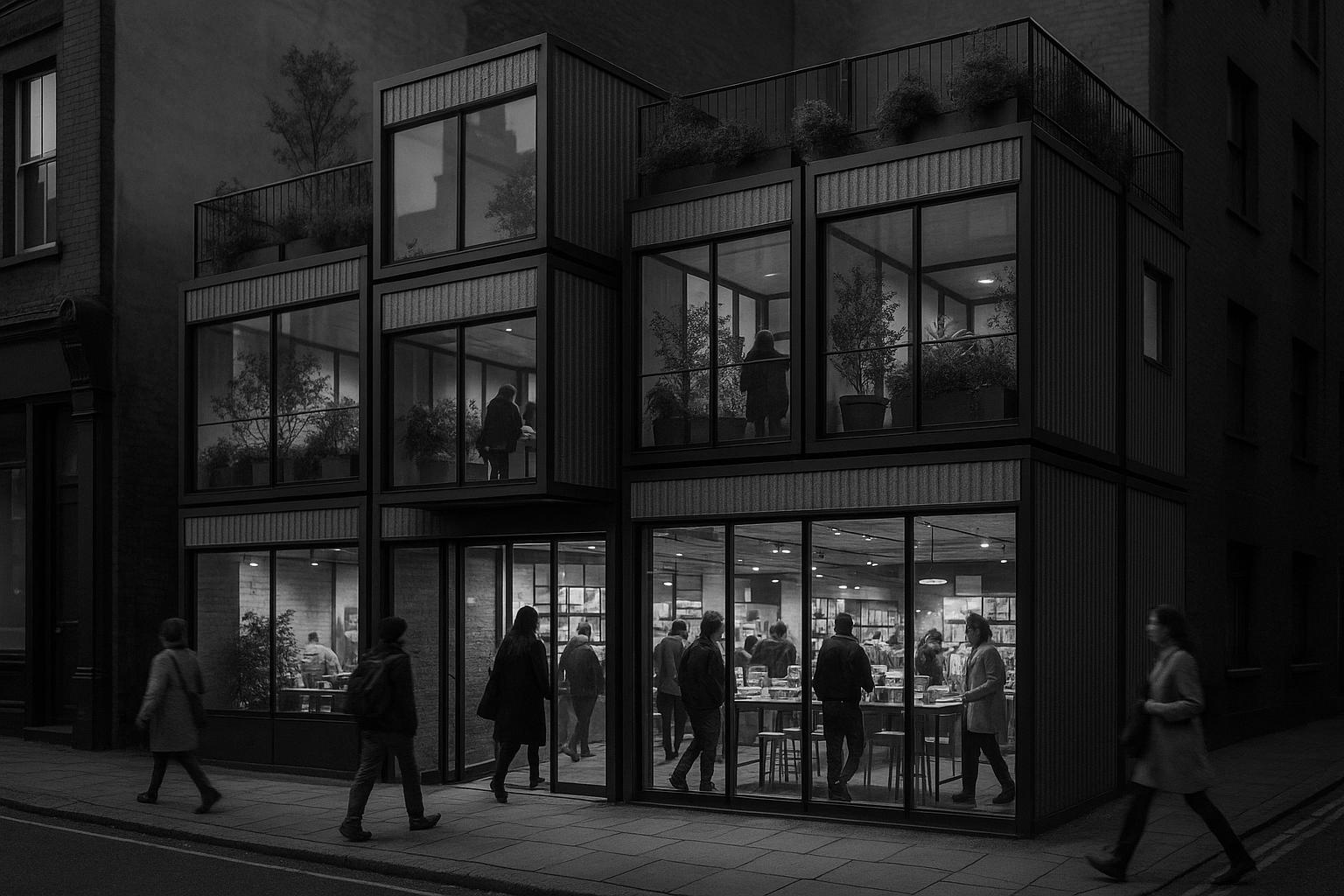Two London practices have proposed street‑facing, mixed‑use storage schemes that pair lockers with co‑working, community space and retail, aiming to make self‑storage an integrated, energy‑efficient part of neighbourhood life rather than an industrial outskirts relic.
Two London-based practices are quietly testing a new direction for self-storage, aiming to prove that the sector can sit more happily within city life than the stark, edge-of-town blocks it has long defined. The Architects’ Journal reports that Architecture 00 and Gibson Thornley have pitched two urban-storage schemes to Compound, the developer, with visions for Peckham in south London and New Barnet in north London. Rather than separate huts sprawled along unnamed industrial parks, these proposals bring storage onto the high street and pair it with co-working, community space and light industrial uses. Architecture 00’s five-storey Peckham scheme is designed to sit on a cleared plot along a busy corridor, offering an active frontage, planted decks and a ground-floor legibility that aims to invite passers-by in. Pepper emphasises a shift toward a “domestic rather than industrial feel,” a move intended to make the building read as part of the neighbourhood rather than a fortress on the outskirts. In New Barnet, Thornley’s low-rise proposal for Gibson Thornley likewise seeks to repair the street frontage by matching height and rhythm to surrounding homes, and by adopting a metallic and precast concrete palette inspired by High-Tech architecture. Both schemes are pitched as flexible, energy-efficient hybrids capable of accommodating evolving uses and a variety of users, from local residents to start-ups seeking a public-facing address.
The broader design conversation around these schemes is less about size and capacity and more about how storage can be beautiful, durable and integrated into urban life. Industry commentary and project reviews describe a shift away from “soulless” or hostile facilities toward façades, massing and landscaping that help such buildings sit comfortably within streets and communities. The New Shape of Self-Storage argues that municipalities increasingly demand sophisticated façades, active frontages and a streetscape that blends with its surroundings, with multi-storey urban facilities and varied materials helping to camouflage storage as a legitimate urban element. Across these discussions, the prospect of combining storage with retail, workspace or community uses features prominently, creating facilities that function as welcoming, legible parts of the city and are equipped with energy-efficient systems and advanced access technology. With co-located spaces on the high street, Pepper notes, small and micro businesses that grew during the Covid era now seek public-facing presence, while the rise of compact urban living makes on-demand storage an everyday utility rather than a last resort.
Design writers emphasise both the architectural opportunity and the practical hurdles of pursuing such mixed-use, street-facing storage. The practical logic is clear: these schemes are intended to be flexible—able to adapt to changing work and living patterns—and to contribute to local economies by activating ground floors and providing accessible, user-friendly interfaces for customers. Bruce Jordan’s A New Dawn for Self-Storage Design argues that the industry has moved beyond utilitarian back rooms toward architecture-led projects that demand curb appeal, ground-floor activation and clear visualisations to engage planning authorities and nearby communities. In parallel, the sector’s move toward lifestyle storage—with transparent façades, street-facing entrances and pedestrian-friendly public realm—is paralleled by calls for smarter planning and, in some cases, the repurposing of existing urban buildings to overcome zoning and cost barriers. The mixed-use approach is being framed as the next frontier, with robotics and automation at the ready to support dense city sites and dynamic customer needs.
A broader market arc supports these architectural ambitions. GlobeSt highlights a growing appetite among investors for adaptive reuse of existing buildings as a route into urban self-storage, noting that roughly 191 million square feet of storage space has been created via repurposing since 2014–2023, led by cities such as Chicago, New York and Philadelphia. The upside, industry watchers say, includes lower upfront costs, faster market entry and the ability to fit climate-controlled units and on-site services into sites with established transport links. Taken together with the architectural interest in canopies, trellises and other street-ready devices, the story is less about building bigger sheds and more about designing storage as a visible, well-designed element of the urban fabric—one that can host a workforce, a community hub and a flexible home for possessions, all within walking distance of daily life.
Referencing this broader shift, ArchDaily’s Design Depot illustrates how storage projects can range from subtle interior systems to bold urban interventions, underscoring that storage can be a design feature in its own right. In the context of the UK proposals, the lesson is clear: well-designed storage that looks outward to the street and inward to user needs has the potential to reframe what a lock-up can be, from a temporary necessity to a long-term civic asset.
Reference Map:
Source: Noah Wire Services
- https://www.architectsjournal.co.uk/news/thinking-inside-the-box-why-the-self-storage-revolution-will-be-well-designed – Please view link – unable to able to access data
- https://www.insideselfstorage.com/facility-design/the-new-shape-of-self-storage-facility-design-arcs-toward-beauty-durability-economy-and-sustainability – Inside Self-Storage’s ‘The New Shape of Self-Storage’ explains that storage architecture is shedding its dull, fortress-like image in favour of buildings that are beautiful, durable and capable of integrating with surrounding streets. Municipalities increasingly demand more sophisticated façades, massing and landscaping, leading to ‘camouflaged’ storage that sits comfortably in commercial or residential contexts. The piece highlights the shift to multi-storey urban facilities, varied materials and active frontages, while addressing energy efficiency, climate control and advanced access technology. It also notes opportunities to combine storage with retail, workspace or community uses, creating facilities that serve as welcoming, legible parts of the city.
- https://www.insideselfstorage.com/facility-design/a-new-dawn-for-self-storage-design – Bruce Jordan’s ‘A New Dawn for Self-Storage Design’ argues that self-storage has moved from purely functional back-office assets to architecture-led projects. It traces a transition from plain, industrial façades to varied massing, materials and street-facing fronts, including canopies and trellises that enliven the street. The article discusses curb appeal, ground-floor activation and the need to engage planning authorities through clear visualisations and sensitivity to context. It also notes technology-driven trends, with digital leasing, mobile credentials and on-site kiosks shaping the customer experience, and the broader move towards flexible offices or work hubs alongside storage schemes.
- https://www.insideselfstorage.com/mixed-use-projects/mixed-use-development-the-next-frontier-for-self-storage – This Inside Self-Storage feature surveys how self-storage has evolved from rural, single-storey facilities to urban mixed-use schemes that sit beside retail, offices and homes. It highlights Chicago’s Clybourn Galleria and similar conversions, showing how storage can be embedded in vibrant corridors. The article argues that mixed-use helps address planning challenges, unlocks higher rents and creates pedestrian activity. It promotes ‘lifestyle storage’ with street-level entrances and windows, while emphasising compatibility with surrounding architecture and streetscape to ensure the scheme sits well within its urban context.
- https://www.insideselfstorage.com/mixed-use-projects/exploring-a-mixed-use-approach-to-self-storage-development – Exploring a Mixed-Use Approach to Self-Storage Development discusses how architects and developers pursue mixed-use layouts to access prime urban sites. It notes planning and zoning hurdles and the need to persuade communities that storage can sit alongside retail, offices or housing as a ‘good neighbour’. The piece advocates lifestyle storage with transparent façades, street-facing entrances and pedestrian-friendly public realm, and stresses principles of compatibility, functional efficiency and long-term flexibility. It also mentions robotics and automation as potential enhancements to make dense urban storage viable.
- https://www.globest.com/2024/10/31/investors-embrace-adaptive-reuse-for-urban-self-storage-projects/ – GlobeSt reports a shift in urban self-storage toward adaptive reuse of existing buildings, driven by zoning constraints and high development costs. Citing StorageCafe, it states that about 191 million square feet (roughly 9%) of self-storage space has been created through repurposing since 2014–2023, with Chicago, New York and Philadelphia leading. The article emphasises the appeal of lifestyle storage, lower upfront costs and faster market access, noting how repurposed retail and industrial sites can accommodate climate-controlled units and on-site services while benefiting from established transport links.
- https://www.archdaily.com/965783/design-depot-30-projects-that-explore-diverse-storage-solutions – ArchDaily’s Design Depot compiles 30 projects illustrating diverse storage design approaches. It ranges from hidden storage integrated within interiors to wall-mounted and elevated systems, exposed shelving and movable mechanisms in retail, and mechanical solutions in large‑scale spaces. The article demonstrates that storage can act as a design feature, rather than a mere utilitarian backroom, and shows how material choice, scale and flexibility allow storage spaces to function across homes, offices and commercial contexts. It also highlights the potential for storage to contribute to interior architecture and urban design through inventive typologies.
Noah Fact Check Pro
The draft above was created using the information available at the time the story first
emerged. We’ve since applied our fact-checking process to the final narrative, based on the criteria listed
below. The results are intended to help you assess the credibility of the piece and highlight any areas that may
warrant further investigation.
Freshness check
Score:
5
Notes:
 The narrative is not wholly new — elements of the story (design-led self‑storage, mixed-use storage, adaptive reuse figures) have been published previously. Earliest closely related industry commentary dates back to at least 2018 (Bruce Jordan on design trends). ([insideselfstorage.com](https://www.insideselfstorage.com/facility-design/a-new-dawn-for-self-storage-design?utm_source=chatgpt.com)) Key, recent industry reporting that the article cites (adaptive‑reuse figures, investor appetite) appears in Oct–Nov 2024 (GlobeSt, local reporting on Compound/Barnet). ([globest.com](https://www.globest.com/2024/10/31/investors-embrace-adaptive-reuse-for-urban-self-storage-projects/?utm_source=chatgpt.com), [barnetsociety.org.uk](https://www.barnetsociety.org.uk/plans-to-develop-site-of-workshops-on-a1000-between-high-barnet-and-whetstone-with-new-facility-for-self-storage/?utm_source=chatgpt.com)) Several claims and trends therefore pre-date this narrative by months–years (≫7 days).
The narrative is not wholly new — elements of the story (design-led self‑storage, mixed-use storage, adaptive reuse figures) have been published previously. Earliest closely related industry commentary dates back to at least 2018 (Bruce Jordan on design trends). ([insideselfstorage.com](https://www.insideselfstorage.com/facility-design/a-new-dawn-for-self-storage-design?utm_source=chatgpt.com)) Key, recent industry reporting that the article cites (adaptive‑reuse figures, investor appetite) appears in Oct–Nov 2024 (GlobeSt, local reporting on Compound/Barnet). ([globest.com](https://www.globest.com/2024/10/31/investors-embrace-adaptive-reuse-for-urban-self-storage-projects/?utm_source=chatgpt.com), [barnetsociety.org.uk](https://www.barnetsociety.org.uk/plans-to-develop-site-of-workshops-on-a1000-between-high-barnet-and-whetstone-with-new-facility-for-self-storage/?utm_source=chatgpt.com)) Several claims and trends therefore pre-date this narrative by months–years (≫7 days).  Where the narrative reports local project pitches (Architecture 00 / Gibson Thornley to Compound) those may be more recent, but local planning and developer announcements (Compound’s Meadow Works / Great North Road proposals) were public by Nov 2024 and planning filings in Mar 2025 — i.e. earlier than some reprints. ([barnetsociety.org.uk](https://www.barnetsociety.org.uk/plans-to-develop-site-of-workshops-on-a1000-between-high-barnet-and-whetstone-with-new-facility-for-self-storage/?utm_source=chatgpt.com), [planning.org.uk](https://planning.org.uk/app/78/STN1C3JIFUW00?utm_source=chatgpt.com)) If the piece is presented as breaking news, that is misleading; it is primarily a synthesis and contextualisation of established trends.
Where the narrative reports local project pitches (Architecture 00 / Gibson Thornley to Compound) those may be more recent, but local planning and developer announcements (Compound’s Meadow Works / Great North Road proposals) were public by Nov 2024 and planning filings in Mar 2025 — i.e. earlier than some reprints. ([barnetsociety.org.uk](https://www.barnetsociety.org.uk/plans-to-develop-site-of-workshops-on-a1000-between-high-barnet-and-whetstone-with-new-facility-for-self-storage/?utm_source=chatgpt.com), [planning.org.uk](https://planning.org.uk/app/78/STN1C3JIFUW00?utm_source=chatgpt.com)) If the piece is presented as breaking news, that is misleading; it is primarily a synthesis and contextualisation of established trends.  Strength: ties to contemporaneous local planning activity and industry reporting give it relevance;
Strength: ties to contemporaneous local planning activity and industry reporting give it relevance;  Risk: much of the substance is recycled from prior trade coverage and reports, so freshness is moderate.
Risk: much of the substance is recycled from prior trade coverage and reports, so freshness is moderate.
Quotes check
Score:
7
Notes:
 I searched for the direct quote attributed to ‘Pepper’ — “domestic rather than industrial feel” — and found no earlier identical matches in open web indexes, suggesting the wording may be original to this piece or to the AJ interview. ([architectsjournal.co.uk](https://www.architectsjournal.co.uk/archive/thinking-inside-the-box-2?utm_source=chatgpt.com), [architecture00.net](https://www.architecture00.net/about?utm_source=chatgpt.com)) If the phrase first appeared in the Architects’ Journal interview, that would make it an original quote for that narrative (positive for originality).
I searched for the direct quote attributed to ‘Pepper’ — “domestic rather than industrial feel” — and found no earlier identical matches in open web indexes, suggesting the wording may be original to this piece or to the AJ interview. ([architectsjournal.co.uk](https://www.architectsjournal.co.uk/archive/thinking-inside-the-box-2?utm_source=chatgpt.com), [architecture00.net](https://www.architecture00.net/about?utm_source=chatgpt.com)) If the phrase first appeared in the Architects’ Journal interview, that would make it an original quote for that narrative (positive for originality).  However, the broader idea (shifting from fortress/industrial aesthetics to domestic/more integrated façades) is longstanding in trade reporting (e.g. Inside Self‑Storage pieces dating back to 2016–2018). ([insideselfstorage.com](https://www.insideselfstorage.com/self-storage-construction/creating-panache-in-self-storage-facility-design?utm_source=chatgpt.com)) If identical wording appears elsewhere in paywalled or offline transcripts, I could not confirm it; limited access to the full AJ page (robots/crawl restrictions) constrained retrieval of the AJ page text for independent quote matching.
However, the broader idea (shifting from fortress/industrial aesthetics to domestic/more integrated façades) is longstanding in trade reporting (e.g. Inside Self‑Storage pieces dating back to 2016–2018). ([insideselfstorage.com](https://www.insideselfstorage.com/self-storage-construction/creating-panache-in-self-storage-facility-design?utm_source=chatgpt.com)) If identical wording appears elsewhere in paywalled or offline transcripts, I could not confirm it; limited access to the full AJ page (robots/crawl restrictions) constrained retrieval of the AJ page text for independent quote matching.  Recommendation: verify the AJ interview transcript or contact the speaker (Lynton Pepper at Architecture 00) for confirmation if exact provenance of the phrasing matters.
Recommendation: verify the AJ interview transcript or contact the speaker (Lynton Pepper at Architecture 00) for confirmation if exact provenance of the phrasing matters.
Source reliability
Score:
9
Notes:
 The narrative draws on reputable professional outlets and verifiable organisations: The Architects’ Journal (industry publication), Inside Self‑Storage (trade publication), GlobeSt (commercial‑property trade), Architecture 00 and Gibson Thornley (established practices), and Compound (developer with a public project list). ([architectsjournal.co.uk](https://www.architectsjournal.co.uk/archive/thinking-inside-the-box-2?utm_source=chatgpt.com), [insideselfstorage.com](https://www.insideselfstorage.com/facility-design/a-new-dawn-for-self-storage-design?utm_source=chatgpt.com), [globest.com](https://www.globest.com/2024/10/31/investors-embrace-adaptive-reuse-for-urban-self-storage-projects/?utm_source=chatgpt.com), [architecture00.net](https://www.architecture00.net/about?utm_source=chatgpt.com), [compound-re.com](https://compound-re.com/development-projects/?utm_source=chatgpt.com)) These are credible, subject‑relevant sources.
The narrative draws on reputable professional outlets and verifiable organisations: The Architects’ Journal (industry publication), Inside Self‑Storage (trade publication), GlobeSt (commercial‑property trade), Architecture 00 and Gibson Thornley (established practices), and Compound (developer with a public project list). ([architectsjournal.co.uk](https://www.architectsjournal.co.uk/archive/thinking-inside-the-box-2?utm_source=chatgpt.com), [insideselfstorage.com](https://www.insideselfstorage.com/facility-design/a-new-dawn-for-self-storage-design?utm_source=chatgpt.com), [globest.com](https://www.globest.com/2024/10/31/investors-embrace-adaptive-reuse-for-urban-self-storage-projects/?utm_source=chatgpt.com), [architecture00.net](https://www.architecture00.net/about?utm_source=chatgpt.com), [compound-re.com](https://compound-re.com/development-projects/?utm_source=chatgpt.com)) These are credible, subject‑relevant sources.  Caveat: direct access to the AJ page was limited by robots.txt on some crawlers, so I relied on archive/index snippets; confirm full AJ text where necessary.
Caveat: direct access to the AJ page was limited by robots.txt on some crawlers, so I relied on archive/index snippets; confirm full AJ text where necessary.  No evidence found of the narrative being propagated by low‑quality clickbait networks — published references are mainstream/trade; no proliferation across dubious farms detected in my searches.
No evidence found of the narrative being propagated by low‑quality clickbait networks — published references are mainstream/trade; no proliferation across dubious farms detected in my searches.
Plausability check
Score:
8
Notes:
The central claims are plausible and supported by industry reporting: a shift to more considered façades, mixed‑use and adaptive reuse, and investor interest in urban self‑storage have been documented (Inside Self‑Storage trends, GlobeSt adaptive‑reuse data). ([insideselfstorage.com](https://www.insideselfstorage.com/facility-design/a-new-dawn-for-self-storage-design?utm_source=chatgpt.com), [globest.com](https://www.globest.com/2024/10/31/investors-embrace-adaptive-reuse-for-urban-self-storage-projects/?utm_source=chatgpt.com))  Local project claims (Compound’s Meadow Works / Great North Road Barnet proposals and community consultation for co‑located co‑working / cafe) are corroborated by local reporting and planning entries (Barnet Society and planning listings). ([barnetsociety.org.uk](https://www.barnetsociety.org.uk/plans-to-develop-site-of-workshops-on-a1000-between-high-barnet-and-whetstone-with-new-facility-for-self-storage/?utm_source=chatgpt.com), [planning.org.uk](https://planning.org.uk/app/78/STN1C3JIFUW00?utm_source=chatgpt.com))
Local project claims (Compound’s Meadow Works / Great North Road Barnet proposals and community consultation for co‑located co‑working / cafe) are corroborated by local reporting and planning entries (Barnet Society and planning listings). ([barnetsociety.org.uk](https://www.barnetsociety.org.uk/plans-to-develop-site-of-workshops-on-a1000-between-high-barnet-and-whetstone-with-new-facility-for-self-storage/?utm_source=chatgpt.com), [planning.org.uk](https://planning.org.uk/app/78/STN1C3JIFUW00?utm_source=chatgpt.com))  Missing / weak details: the narrative aggregates sector figures (e.g. 191 million sq ft repurposed) that trace to industry reports cited by GlobeSt — check the primary StorageCafe / Storage industry report if precise numbers are critical. ([globest.com](https://www.globest.com/2024/10/31/investors-embrace-adaptive-reuse-for-urban-self-storage-projects/?utm_source=chatgpt.com))
Missing / weak details: the narrative aggregates sector figures (e.g. 191 million sq ft repurposed) that trace to industry reports cited by GlobeSt — check the primary StorageCafe / Storage industry report if precise numbers are critical. ([globest.com](https://www.globest.com/2024/10/31/investors-embrace-adaptive-reuse-for-urban-self-storage-projects/?utm_source=chatgpt.com))  Tone and scope: language appears consistent with professional trade commentary; no obvious region‑incongruent spelling or phrasing was detected. Overall: plausible, but where specific quantification or unique claims are made, verify against the primary industry report or planning documents.
Tone and scope: language appears consistent with professional trade commentary; no obvious region‑incongruent spelling or phrasing was detected. Overall: plausible, but where specific quantification or unique claims are made, verify against the primary industry report or planning documents.
Overall assessment
Verdict (FAIL, OPEN, PASS): OPEN
Confidence (LOW, MEDIUM, HIGH): MEDIUM
Summary:
 OPEN — Medium confidence. The narrative is credible and largely drawn from reputable industry and local reporting, but it is not wholly original or freshly broken.
OPEN — Medium confidence. The narrative is credible and largely drawn from reputable industry and local reporting, but it is not wholly original or freshly broken.  Strengths: reputable publications and verifiable actors (Architecture 00, Gibson Thornley, Compound) appear in the reporting; industry trade pieces and commercial‑property coverage independently document the same design trends and adaptive‑reuse figures (e.g. Inside Self‑Storage, GlobeSt). ([insideselfstorage.com](https://www.insideselfstorage.com/facility-design/a-new-dawn-for-self-storage-design?utm_source=chatgpt.com), [globest.com](https://www.globest.com/2024/10/31/investors-embrace-adaptive-reuse-for-urban-self-storage-projects/?utm_source=chatgpt.com))
Strengths: reputable publications and verifiable actors (Architecture 00, Gibson Thornley, Compound) appear in the reporting; industry trade pieces and commercial‑property coverage independently document the same design trends and adaptive‑reuse figures (e.g. Inside Self‑Storage, GlobeSt). ([insideselfstorage.com](https://www.insideselfstorage.com/facility-design/a-new-dawn-for-self-storage-design?utm_source=chatgpt.com), [globest.com](https://www.globest.com/2024/10/31/investors-embrace-adaptive-reuse-for-urban-self-storage-projects/?utm_source=chatgpt.com))  Freshness caveat: core themes and many data points predate this narrative by months to years (earliest comparable coverage found from 2016–2018 for design trends and 2024 for adaptive‑reuse investor pieces), so the piece reads as synthesis/contextualisation rather than exclusive breaking news. ([insideselfstorage.com](https://www.insideselfstorage.com/self-storage-construction/creating-panache-in-self-storage-facility-design?utm_source=chatgpt.com), [globest.com](https://www.globest.com/2024/10/31/investors-embrace-adaptive-reuse-for-urban-self-storage-projects/?utm_source=chatgpt.com))
Freshness caveat: core themes and many data points predate this narrative by months to years (earliest comparable coverage found from 2016–2018 for design trends and 2024 for adaptive‑reuse investor pieces), so the piece reads as synthesis/contextualisation rather than exclusive breaking news. ([insideselfstorage.com](https://www.insideselfstorage.com/self-storage-construction/creating-panache-in-self-storage-facility-design?utm_source=chatgpt.com), [globest.com](https://www.globest.com/2024/10/31/investors-embrace-adaptive-reuse-for-urban-self-storage-projects/?utm_source=chatgpt.com))  Key risks that prevent a PASS: (1) recycled/trade‑familiar content — much of the argumentation and examples echo prior trade reporting; (2) one quoted phrase (attributed to Pepper) has no earlier matches online and may be original to the AJ interview, but AJ page access was limited for independent verification; (3) some numerical claims should be traced back to primary reports (StorageCafe / industry data) for accuracy. ([globest.com](https://www.globest.com/2024/10/31/investors-embrace-adaptive-reuse-for-urban-self-storage-projects/?utm_source=chatgpt.com)) Recommended next steps for an editor: (a) verify the AJ interview transcript or contact Lynton Pepper / Architecture 00 to confirm the quote and project dates (
Key risks that prevent a PASS: (1) recycled/trade‑familiar content — much of the argumentation and examples echo prior trade reporting; (2) one quoted phrase (attributed to Pepper) has no earlier matches online and may be original to the AJ interview, but AJ page access was limited for independent verification; (3) some numerical claims should be traced back to primary reports (StorageCafe / industry data) for accuracy. ([globest.com](https://www.globest.com/2024/10/31/investors-embrace-adaptive-reuse-for-urban-self-storage-projects/?utm_source=chatgpt.com)) Recommended next steps for an editor: (a) verify the AJ interview transcript or contact Lynton Pepper / Architecture 00 to confirm the quote and project dates ( supports originality claim); (b) check primary industry reports (e.g. StorageCafe) for the adaptive‑reuse square‑footage figures before republishing numbers; (c) if the piece is presented as breaking, consider labelling it a commentary/synthesis to avoid implying exclusivity.
supports originality claim); (b) check primary industry reports (e.g. StorageCafe) for the adaptive‑reuse square‑footage figures before republishing numbers; (c) if the piece is presented as breaking, consider labelling it a commentary/synthesis to avoid implying exclusivity. 













